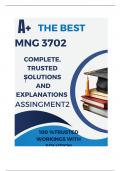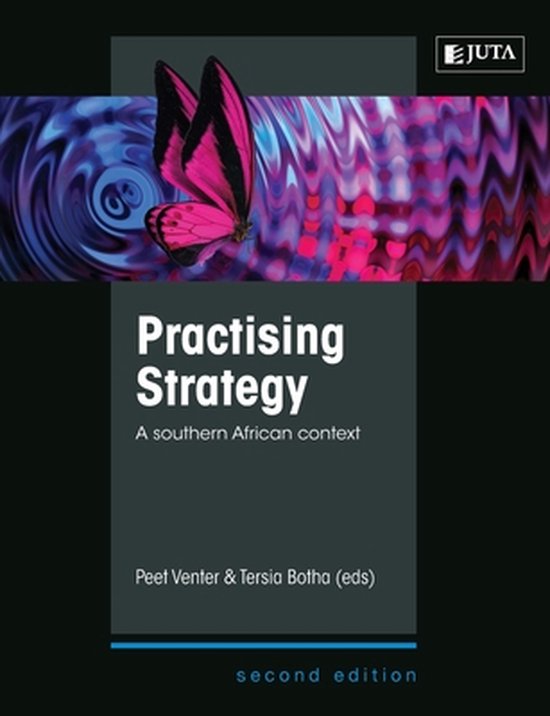,MNG3702 Assignment 2 (COMPLETE ANSWERS) Semester 2
2024 - DUE September 2024 ; 100% TRU
Michelin is a leading French brand and manufacturer of tires and rubber
products.The company was founded in 1888 by two Michelin brothers and
grew to one of the largest tyre manufacturers in the world, with a market share
of 14.8% in 2023. Oddly enough, the company also sells popular travel guides
and road maps. They can make or break chefs by the number of Michelin
stars they award to their restaurants. Michelin stars are a rating system used
by the red Michelin Guide to grade restaurants on their quality and excellence.
Restaurants can be awarded one, two or three stars, based on various
criteria, such as quality of their ingredients used, the harmony of flavours in
their dishes, the mastery of various techniques, the personality of the chef,
and the consistency of the menu. The Michelin Man (Bibendum) is known
word wide. The history of the Michelin Guide The Michelin Guide is
considered by many to be the hallmark of global fine dining and quality
cuisine. It has immense power over chefs, restaurateurs, and foodies world
wide. It may divide opinions across the food service industry, but its influence
is undeniable. French chef Paul Bocuse, a pioneer of nouvelle cuisine (a
modern French style of preparing dishes that avoids rich, heavy foods, rather
emphasizing the freshness of the ingriedients used in prepring the dishes and
the presentation thereof), once said, “Michelin is the only guide that counts.”
The birth of the famous little red book is a very interesting story. When the
Michelin tire company was established in 1888 by brothers André and
Édouard Michelin, it was a time when driving was perceived as a novelty to
most. There were less than 3 000 cars in France at the time. However, the
brothers were quick to recognize driving and mobility as a lasting trend. To
encourage more road travel, and hence boost tire sales, they decided to
create a comprehensive guidebook for motorists which catalogued hotels,
restaurants, mechanics, and gas stations. In 1900, the very first edition of the
Michelin Guide was published, and 35 000 copies were given out for free. 3
MNG3702
Argumentative Essay on the Michelin Guide: Register and Tone,
Cohesion, Coherence, and Grammatical Expression
Introduction
Michelin, a leading French tire manufacturer, has also established itself as a
global authority in fine dining through its Michelin Guide. This essay examines
the text discussing Michelin's dual legacy in tire manufacturing and culinary
,ratings, focusing on its register and tone, cohesion, coherence, grammatical
expression, and content. By analyzing these elements, we can better
understand the text's effectiveness in conveying the influence of the Michelin
Guide in the culinary world.
Register and Tone
The text employs a formal yet accessible register, suitable for a wide audience
ranging from casual readers to industry professionals. The tone is informative
and respectful, reflecting the significance of Michelin's contributions to both
tire manufacturing and fine dining. Phrases like "Michelin is a leading French
brand and manufacturer of tires and rubber products" set a professional tone,
while the explanation of the Michelin Guide’s influence on chefs and
restaurateurs is conveyed with a sense of admiration and respect. The tone
remains consistent throughout, ensuring that the reader perceives the content
as credible and authoritative.
Cohesion and Coherence
The text demonstrates strong cohesion and coherence, effectively guiding the
reader through Michelin's history and its impact on the culinary world. Each
paragraph logically follows the previous one, maintaining a clear and
organized flow of information. For instance, the transition from discussing
Michelin’s founding to its creation of the guidebook is seamless: "To
encourage more road travel, and hence boost tire sales, they decided to
create a comprehensive guidebook for motorists which catalogued hotels,
restaurants, mechanics, and gas stations." This smooth progression helps
maintain the reader's interest and understanding.
Grammatical Expression
The grammatical expression in the text is precise and well-crafted,
contributing to its overall clarity and readability. Sentences are well-structured
and varied in length, which keeps the reader engaged. For example, the
sentence, "Restaurants can be awarded one, two, or three stars, based on
various criteria, such as the quality of their ingredients used, the harmony of
flavors in their dishes, the mastery of various techniques, the personality of
the chef, and the consistency of the menu," is complex but clear, effectively
conveying the multifaceted criteria of the Michelin star rating system. Minor
errors, such as "ingriedients" instead of "ingredients," are present but do not
significantly detract from the text's overall quality.
, Content
The content of the text is rich with historical and contextual information,
providing a comprehensive overview of Michelin's dual legacy. The
explanation of the Michelin Guide’s origins is particularly compelling,
highlighting how the guide was initially intended to promote road travel and
tire sales. The text states, "In 1900, the very first edition of the Michelin Guide
was published, and 35,000 copies were given out for free," illustrating the
guide's humble beginnings and its evolution into a globally recognized
authority in fine dining. The inclusion of French chef Paul Bocuse's quote,
“Michelin is the only guide that counts,” underscores the guide's prestigious
reputation within the culinary community.
The discussion of the Michelin star rating system is thorough and informative,
explaining the criteria used to evaluate restaurants. This section not only
informs the reader about the rating process but also emphasizes the guide's
rigorous standards and its impact on chefs' careers. The text’s exploration of
the Michelin Man (Bibendum) and the global recognition of this mascot adds
an interesting cultural dimension, enhancing the reader's appreciation of the
brand's widespread influence.
Conclusion
In conclusion, the text effectively conveys the dual legacy of Michelin as both
a tire manufacturer and a culinary authority through its formal register and
respectful tone, clear cohesion and coherence, precise grammatical
expression, and rich content. By providing a detailed and engaging account of
Michelin's history and the significance of the Michelin Guide, the text
successfully highlights the brand's lasting impact on both the automotive and
culinary industries. This analysis demonstrates how the structure and
language of the text contribute to its persuasive power, making a strong case
for Michelin's unparalleled influence in the world of fine dining.
Argumentative Essay on the Impact of Banning Mobile Phones in
Schools
Introduction





